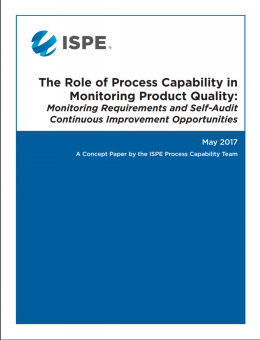Role of Process Capability in Monitoring Product Quality
1 Introduction
ASTM defines process capability as the natural or inherent behavior of a stable process that is in a state of statistical control, which is achieved when the process exhibits no detectable patterns or trends (ASTM E2281 [1]). Statistical tools, such as control charts, are utilized in the determination of process capability, and capability indices are commonly reported. Conceptually, these indices are the ratio of the range of the tolerance defined by its specifications compared to the range occupied by the inherent variability of the process. Process capability is not a regulatory requirement, but it is a supporting tool that helps organizations understand how a particular process is behaving and, therefore, may be used to support product quality. For example, maximizing this ratio reduces risk to the patient, reduces the risk of drug shortages, and enables companies to provide products more reliably to patients around the world. Improving capability requires prioritization and a comprehensive understanding of the most important sources of variability in the process, excipients, raw materials, components, equipment, and supply chain. Through understanding of this variability, action plans aimed at controlling and reducing variability can be implemented. This concept paper explores key considerations and challenges associated with implementation of process capability indices within the pharmaceutical industry.
Statistical Process Control (SPC) is more than control charts alone; it is a comprehensive set of tools that can be used to:
- Understand the process
- Understand the causes of variation
- Eliminate the sources of variation
These tools include histograms, control charts, pareto analysis, cause and effect diagrams, check sheets, scatter plots, and stratification, referred to as quality leader Kaoru Ishikawa’s “magnificent seven.”
The relevance of this to the pharmaceutical industry can be seen in the US FDA Guidance for Industry on Process Validation (2011) [2], which highlights that manufacturers should:
- Understand the sources of variation
- Detect the presence and degree of variation
- Understand the impact of variation on the process and, ultimately, on product attributes
- Control variation in a manner commensurate with the risk it represents to the process/product
Statistical process control has been widely utilized across manufacturing industries for decades. The automotive industry has leveraged such analyses since the 1980s, using SPC to prevent nonconforming product, support continuous improvement initiatives, and communicate areas of risk across the supply chain (Kane, 1986 [3]). Likewise, environmental protection has implemented these analysis tools in the quantitative evaluation of environmental performance of a plant with respect to prevailing regulations (Kahraman, 2009 [4]; Corbett, 2002 [5]). Industries involved in machining and precision tooling require such statistical analysis methods in order to assure machine tool/process stability and enable the manufacture of highly precise components (Motorcu, 2006 [6]). The nuclear industry has applied statistical control methods to evaluate material balances through their facilities. This is done in order to detect losses and mitigate risks (Prasad, 1999 [7]). Other examples are highlighted in Table 1.1.
Read more by downloading Role of Process Capability in Monitoring Product Quality (Published: May 2017).
